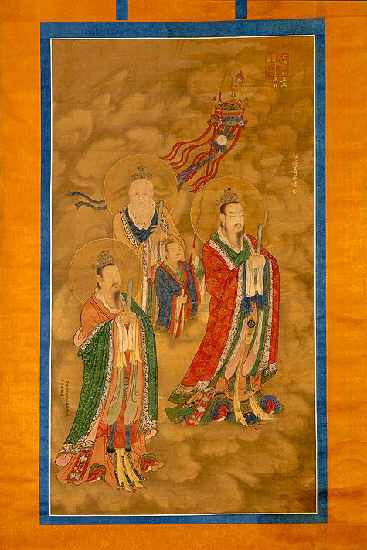| |

The Three Star Gods
The three stars of Good Fortune, Emolument, and Longevity form a popular
group of gods. Still today, they remain the most commonly depicted Chinese
deities. Their worship seems to have begun in the 15th century; only the
Star of Longevity can be traced to an earlier source. This god is shown
in the upper left as an old man with white beard who looks directly outward.
The other two float below him and look to the right. All three gods hold
tablets and are dressed as Taoist priests. Accompanying them is a smaller
attendant holding a parasol with banners. The inscriptions in gold at
the upper right identify the gods and indicate the date of the painting.
In the third century BCE, China's first emperor worshiped the Star of
Longevity. The other two gods, however, were unknown before the Ming dynasty.
Although they became quite common, there is no scripture devoted to them
in the Taoist Canon. Instead, they seem to have originated as popular
gods outside of the orthodox Taoist tradition.
With one possible exception, this painting is the earliest known depiction
of the group. The first literary source for these three stars is a play
about the lunar New Year's festival, in which the three stars descend
to the mortal world to grant the blessings suggested by their names—good
fortune, wealth, and long life. The play was published only 11 years before
this painting was made. Both of these early sources are connected with
the emperor's family, suggesting that worship of the star-lords may have
been instituted at the imperial level. This is both an example of a popular
movement that originated at the highest levels of society and an important
reminder that popular religion does not necessarily refer to the religion
of uneducated peasants, but also to that of scholars and even the imperial
family.
|

